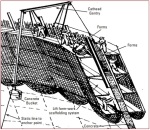In 1978, the Allegheny Power System built a larger power plant at Willow Island, West Virginia. In addition to two smaller units already on site, they were installing two generators with a total capacity of 1300 megawatts. One cooling tower had already been built by April while a second was still in the process of being constructed. On Thursday April 27, 1978 the second tower’s scaffolding collapsed while under construction killing 51 construction workers [a].

[3]
The process of constructing the shell of the cooling tower is depicted in image [3]. As shown in the image, the scaffolding is supported between layers of concrete that have previously been poured. A lift system is also added to the scaffolding form to allow the workers to haul up buckets of concrete to pour into place new layers for the shell. Each layer is called a lift. On the day of the failure, the construction team was working on lift 29, 166 feet high, relying on the concrete from lift 28 to support them. However, the concrete for lift 28 had been poured only 18 hours before the new scaffolding system was placed upon it. Running tests after the collapse showed that the concrete from lift 28 had not yet dried to a compressive strength great enough to support the scaffolding system. When the weight of the scaffolding system with the workers and the buckets of concrete was applied to the lift it failed causing it to collapse and bring down the scaffolding with it [a,b]. 51 construction workers were on the scaffolding at the time of collapse, and all of them fell to their deaths [a]. However, the construction workers in the center of the tower were able to take cover under a concrete truck ramp and avoided fatalities [c].
Another cause of collapse was the anchor point used for lifting the buckets of concrete. Initially the anchor point was located near the wall of the cooling tower, but had been moved close to the center of the tower changing how the lift system was transferring the load to the shell. If the anchor point had not been moved and stayed near the shell wall, the effects of the construction loads would have been reduced to a point where lift 28 would not have failed [b].
This failure was easily avoidable had the construction team decided to ensure the concrete poured the day before had dried enough to support the loads being applied to it. Additionally, had proper analysis been done before moving the anchor point of the lift, the issue of changing how the load was transferred to the shell could have been avoided entirely.

